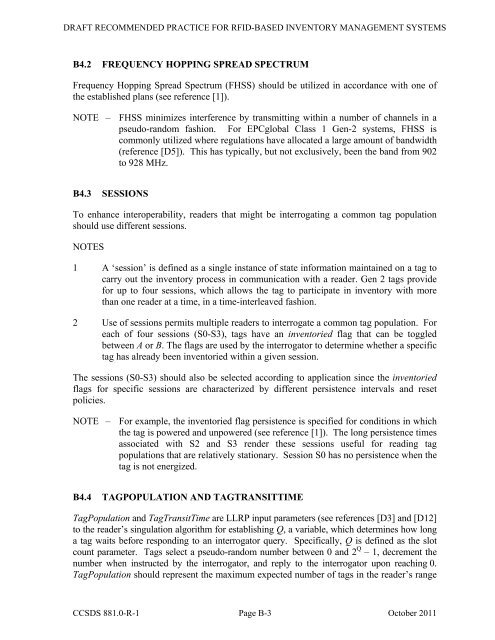CCSDS 881.0-R-1, Spacecraft Onboard Interface ServicesâRFID ...
CCSDS 881.0-R-1, Spacecraft Onboard Interface ServicesâRFID ...
CCSDS 881.0-R-1, Spacecraft Onboard Interface ServicesâRFID ...
Create successful ePaper yourself
Turn your PDF publications into a flip-book with our unique Google optimized e-Paper software.
DRAFT RECOMMENDED PRACTICE FOR RFID-BASED INVENTORY MANAGEMENT SYSTEMSB4.2 FREQUENCY HOPPING SPREAD SPECTRUMFrequency Hopping Spread Spectrum (FHSS) should be utilized in accordance with one ofthe established plans (see reference [1]).NOTE – FHSS minimizes interference by transmitting within a number of channels in apseudo-random fashion. For EPCglobal Class 1 Gen-2 systems, FHSS iscommonly utilized where regulations have allocated a large amount of bandwidth(reference [D5]). This has typically, but not exclusively, been the band from 902to 928 MHz.B4.3 SESSIONSTo enhance interoperability, readers that might be interrogating a common tag populationshould use different sessions.NOTES1 A ‘session’ is defined as a single instance of state information maintained on a tag tocarry out the inventory process in communication with a reader. Gen 2 tags providefor up to four sessions, which allows the tag to participate in inventory with morethan one reader at a time, in a time-interleaved fashion.2 Use of sessions permits multiple readers to interrogate a common tag population. Foreach of four sessions (S0-S3), tags have an inventoried flag that can be toggledbetween A or B. The flags are used by the interrogator to determine whether a specifictag has already been inventoried within a given session.The sessions (S0-S3) should also be selected according to application since the inventoriedflags for specific sessions are characterized by different persistence intervals and resetpolicies.NOTE – For example, the inventoried flag persistence is specified for conditions in whichthe tag is powered and unpowered (see reference [1]). The long persistence timesassociated with S2 and S3 render these sessions useful for reading tagpopulations that are relatively stationary. Session S0 has no persistence when thetag is not energized.B4.4 TAGPOPULATION AND TAGTRANSITTIMETagPopulation and TagTransitTime are LLRP input parameters (see references [D3] and [D12]to the reader’s singulation algorithm for establishing Q, a variable, which determines how longa tag waits before responding to an interrogator query. Specifically, Q is defined as the slotcount parameter. Tags select a pseudo-random number between 0 and 2 Q – 1, decrement thenumber when instructed by the interrogator, and reply to the interrogator upon reaching 0.TagPopulation should represent the maximum expected number of tags in the reader’s range<strong>CCSDS</strong> <strong>881.0</strong>-R-1 Page B-3 October 2011

















